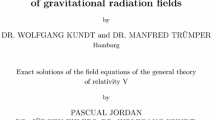Summary
A method is established to solve Einstein’s equations by successive approximations, uniqueness and compatibility at each step being secured by imposing de Donder’s condition on the field. This turns out to restrict the freedom of choice of the sources in a way that determines their laws of motion, directly from the field quantities, without any use of integration around singularities. If the approximation parameter is the reciprocal velocity of light, the first non trivial approximation results in the constancy of the rest mass, and in Newton’s law of attraction. The next step shows that there is no first-order correction to these laws. The third approximation then gives a small correction to the rest mass, which is found to be increased by the presence of other bodies. There is also a second-order correction to the acceleration (not explicitly evaluated here) which causes the perihelion advance in the two-body problem. Te fourth approximation involves a contribution from the radiation field. It is found that in order to fulfil de Donder’s condition, we must introduce into the field a term which is linear in the sources, although it does not appear in the so-called «linear approximation». This result may cast some doubts on the validity of the latter. In a further paper, we shall solve still higher approximations by means of an improved technique, and find that the fifth-order correction to the acceleration involves a non-conservative term. This last result may be taken as evidence for the reality of gravitational radiation.
Riassunto
Si elabora un metodo per risolvere le equazioni di Einstein per approssimazioni successive, l’unicità e la compatibilità essendo assicurate ad ogni passaggio imponendo al campo la condizione di de Donder. Ciò equivale a restringere la libertà di scelta delle sorgenti in modo da determinare le loro leggi di moto direttamente dalle grandezze di campo senza far alcun uso di integrazioni intorno a singolarità. Se il parametro d’approssimazione è il reciproco della velocità della luce, dalla prima approssimazione non banale risulta la costanza della massa a riposo e la legge d’attrazione di Newton. Il passo successivo dimostra che non esistono correzioni del prim’ordine di queste leggi. La terza approssimazione dà poi una piccola correzione della massa a riposo, che si trova aumentata della presenza di altri corpi. C’è anche una correzione del second’ordine dell’accelerazione (qui non calcolata esplicitamente) che provoca la precessione del perielio nel problema dei due corpi. La quarta approssimazione comprende un contributo del campo radiativo. Si trova che per soddisfare la condizione di de Donder dobbiamo introdurre nell’espressione del campo un termine lineare nelle sorgenti per quanto esso non appaia nella cosidetta «approssimazione lineare». Quest’ultimo risultato può far sorgere qualche dubbio sulla validità di tale approssimazione. In un ulteriore lavoro risolveremo approssimazioni superiori per mezzo di una tecnica perfezionata e troveremo che la correzione del quint’ordine dell’accelerazione comprende un termine non conservativo. Quest’ultimo risultato può essere ritenuto una prova della realtà della radiazione gravitazionale.
Similar content being viewed by others
References
B. Bertotti:Nuovo Cimento,4, 898 (1956);6, 755 (1957).
P. T. Hoang:Compt. Rend.,246, 61 (1958).
N. Rosen:Phys. Rev.,57, 147 (1940).
V. A. Fock:Theory of space, time and gravitation (in Russian, Moscow, 1955), p. 441.
L. Landau andE. Lifshitz:The Classical Theory of Fields (English translation, Cambridge, Mass., 1951), p. 324.
A. Trautman:Bull. Acad. Pol. Sc.,6, 407 (1958).
L. Infeld:Rev. Mod. Phys.,29, 398 (1957).
P. Havas:Phys. Rev.,108, 1351 (1957).
J. Lubański:Acta Phys. Pol.,6, 356 (1937).
W. Tulczyew:Bull. Acad. Pol. Sc., Cl. III,5, 279 (1957).
L. Landau andE. Lifshitz: loc. cit., p. 330.
A. S. Eddington:The Mathematical Theory of Relativity Cambridge, 1924), p. 249.
F. R. Crownfield jr. andP. Havas:Phys. Rev.,94, 471 (1954).
B. Bertotti:Nuovo Cimento,2, 231 (1955).
V. A. Fock: loc. cit., p. 385.
At this approximation\(\mathfrak{g}{\mathbf{ }} = {\mathbf{ }}1{\mathbf{ }} + {\mathbf{ }}\frac{1}{2}\mathfrak{g}_2^{00} {\mathbf{ }} = {\mathbf{ }}1{\mathbf{ }} + {\mathbf{ }}2{\mathbf{ }}\sum {(m/R)} \). As this is computed at the point\(\mathop R\limits^A \)=0, we have to omit the infinity self-energy of the particle A. This can be done in a consistent way by the use of «good»δ functions (16).
L. Infeld andJ. Plebański:Bull. Acad. Pol. Sc., Cl. III. 4, 689 (1956);5, 51 (1957).
A. Einstein:The Meaning of Relativity (Princeton, 1953), p. 102.
Author information
Authors and Affiliations
Rights and permissions
About this article
Cite this article
Peres, A. Gravitational motion and radiation — I. Nuovo Cim 11, 617–627 (1959). https://doi.org/10.1007/BF02732320
Received:
Published:
Issue Date:
DOI: https://doi.org/10.1007/BF02732320




